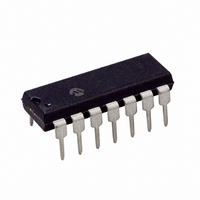PIC16F688-I/P Microchip Technology, PIC16F688-I/P Datasheet - Page 79

PIC16F688-I/P
Manufacturer Part Number
PIC16F688-I/P
Description
IC PIC MCU FLASH 4KX14 14DIP
Manufacturer
Microchip Technology
Series
PIC® 16Fr
Datasheets
1.PIC16F616T-ISL.pdf
(8 pages)
2.PIC16F688T-ISL.pdf
(204 pages)
3.PIC16F688T-ISL.pdf
(6 pages)
4.PIC16F688T-ISL.pdf
(4 pages)
5.PIC16F688T-ISL.pdf
(688 pages)
6.PIC16F688-EP.pdf
(174 pages)
Specifications of PIC16F688-I/P
Program Memory Type
FLASH
Program Memory Size
7KB (4K x 14)
Package / Case
14-DIP (0.300", 7.62mm)
Core Processor
PIC
Core Size
8-Bit
Speed
20MHz
Connectivity
UART/USART
Peripherals
Brown-out Detect/Reset, POR, WDT
Number Of I /o
12
Eeprom Size
256 x 8
Ram Size
256 x 8
Voltage - Supply (vcc/vdd)
2 V ~ 5.5 V
Data Converters
A/D 8x10b
Oscillator Type
Internal
Operating Temperature
-40°C ~ 85°C
Processor Series
PIC16F
Core
PIC
Data Bus Width
8 bit
Data Ram Size
256 B
Interface Type
SCI/USART
Maximum Clock Frequency
20 MHz
Number Of Programmable I/os
12
Number Of Timers
2
Operating Supply Voltage
2 V to 5.5 V
Maximum Operating Temperature
+ 85 C
Mounting Style
Through Hole
3rd Party Development Tools
52715-96, 52716-328, 52717-734
Development Tools By Supplier
PG164130, DV164035, DV244005, DV164005, PG164120, ICE2000, DM163014, DM164120-4
Minimum Operating Temperature
- 40 C
On-chip Adc
8-ch x 10-bit
Data Rom Size
256 B
Height
3.3 mm
Length
19.05 mm
Supply Voltage (max)
5.5 V
Supply Voltage (min)
2 V
Width
6.35 mm
Lead Free Status / RoHS Status
Lead free / RoHS Compliant
For Use With
AC162066 - HEADER INTRFC MPLAB ICD2 20PINAC162061 - HEADER INTRFC MPLAB ICD2 20PINDM163029 - BOARD PICDEM FOR MECHATRONICSAC162056 - HEADER INTERFACE ICD2 16F688ACICE0207 - MPLABICE 14P 300 MIL ADAPTERAC124001 - MODULE SKT PROMATEII 8DIP/SOIC
Lead Free Status / Rohs Status
Lead free / RoHS Compliant
Available stocks
Company
Part Number
Manufacturer
Quantity
Price
Company:
Part Number:
PIC16F688-I/P
Manufacturer:
MICROCHIP
Quantity:
26
Company:
Part Number:
PIC16F688-I/P
Manufacturer:
MOT
Quantity:
61
10.0
The Enhanced Universal Synchronous Asynchronous
Receiver Transmitter (EUSART) module is the serial
I/O module available for PIC16F688 . (EUSART is also
known as a Serial Communications Interface or SCI).
The EUSART can be configured as a full-duplex
asynchronous system that can communicate with
peripheral devices, such as CRT terminals and
personal computers. It can also be configured as a
half-duplex synchronous system that can communicate
with peripheral devices, such as A/D or D/A integrated
circuits, serial EEPROMs, etc.
The EUSART module implements additional features,
including
calibration, automatic wake-up on Break reception and
13-bit Break character transmit. These make it ideally
suited for use in Local Interconnect Network (LIN) bus
systems.
The USART can be configured in the following modes:
• Asynchronous (full-duplex) with:
• Synchronous – Master (half-duplex) with
• Synchronous – Slave (half-duplex) with selectable
In order to configure pins RC4/C2OUT/TX/CK and
RC5/RX/DT
Asynchronous Receiver Transmitter:
• SPEN (RCSTA<7>) bit must be set (= 1),
• TRISC<5> bit must be set (= 1), and
• TRISC<4> bit must be set (= 1).
The operation of the EUSART module is controlled
through three registers:
• Transmit Status and Control (TXSTA)
• Receive Status and Control (RCSTA)
• Baud Rate Control (BAUDCTL)
These are detailed in on the following pages in
Register 10-1,
respectively.
2004 Microchip Technology Inc.
- Auto-wake-up on Break
- Auto baud calibration
- 13-bit Break character transmission
selectable clock polarity
clock polarity
Note:
ENHANCED UNIVERSAL
ASYNCHRONOUS RECEIVER
TRANSMITTER (EUSART)
automatic
The USART control will automatically
reconfigure the pin from input to output as
needed.
as
Register 10-2
the
baud
Universal
rate
and
detection
Register 10-3,
Synchronous
and
Preliminary
10.1
The factory calibrates the internal oscillator block out-
put (INTOSC) for 8 MHz. However, this frequency may
drift as V
affects the asynchronous baud rate. Two methods may
be used to adjust the baud rate clock, but both require
a reference clock source of some kind.
The first (preferred) method uses the OSCTUNE
register to adjust the INTOSC output back to 8 MHz.
Adjusting the value in the OSCTUNE register allows for
fine resolution changes to the system clock source (see
Section 3.4 “Internal Clock Modes” for more
information).
The other method adjusts the value in the baud rate
generator. There may not be fine enough resolution
when adjusting the Baud Rate Generator to compensate
for a gradual change in the peripheral clock frequency.
Clock Accuracy With
Asynchronous Operation
DD
or temperature changes, and this directly
PIC16F688
DS41203B-page 77















